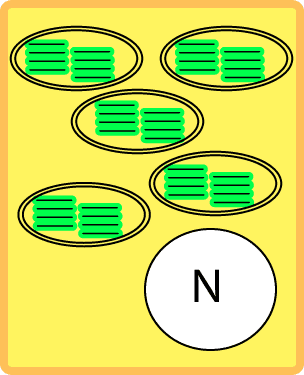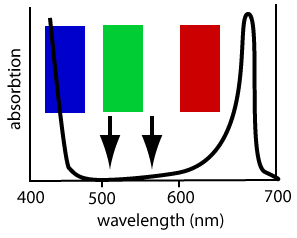This just summarizes the end effect of many complex chemical reactions that take place inside the plant.
Chloroplasts are small organelles inside plant cells which are believed to have once been free living bacteria that could carry out photosynthesis. Several hundred million years ago these bacteria were engulfed by cells that we now call plant cells.
The orange box on the right is a cartoon of a plant cell which contains four oval, double membrane, chloroplasts. Inside the chloroplasts are stacks of membrane discs, thylakoids, that contain chlorophylls. The chlorophylls. are the molecules that actually adsorb the light and give the cell an overall green color.
There are many other organelles and membranes inside a plant cell. The sphere labeled "N" is the nucleus, which contains the genome (DNA) of the cell.


The molecule that adsorbs light, chlorophyll, contains four porphyrin rings. Each five member ring contains four carbon atoms (the carbons are not shown on the diagram, they occur at all unmarked corners) and one nitrogen atom (the "N"). The four nitrogens hold a magnesium atom, "Mg", in the middle of the molecule.
The chlorophyll molecule is very similar in structure to the heme molecule in hemoglobin. However, heme contains an iron molecule instead of magnesium, and its function is to carry oxygen in the blood.

The Sea Star satellite obtains an image of the earth's surface in many wavelengths. The ratio of energy at 510 nm to 555 nm (the two arrows) is used as a measure of the concentration of chlorophyll.